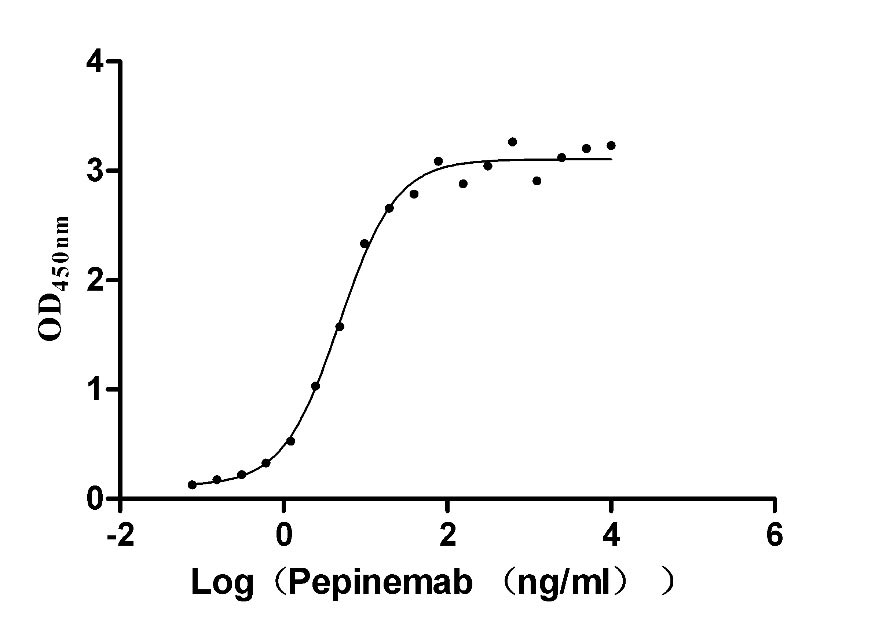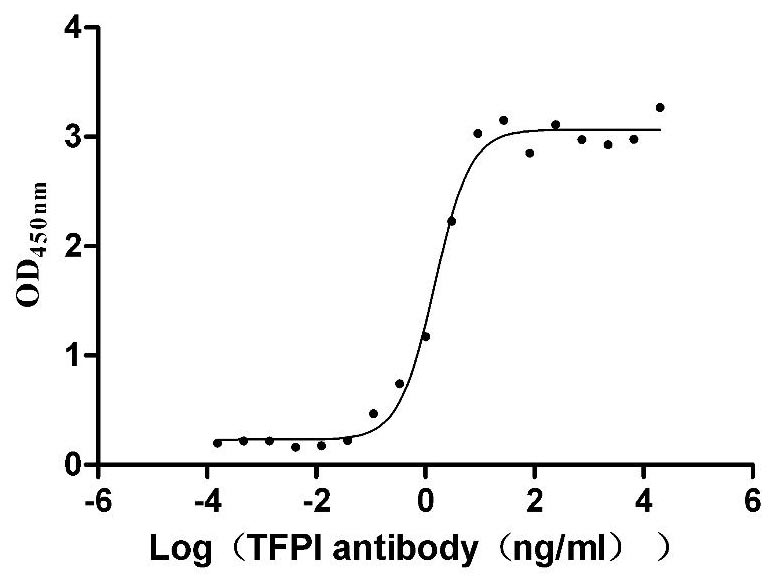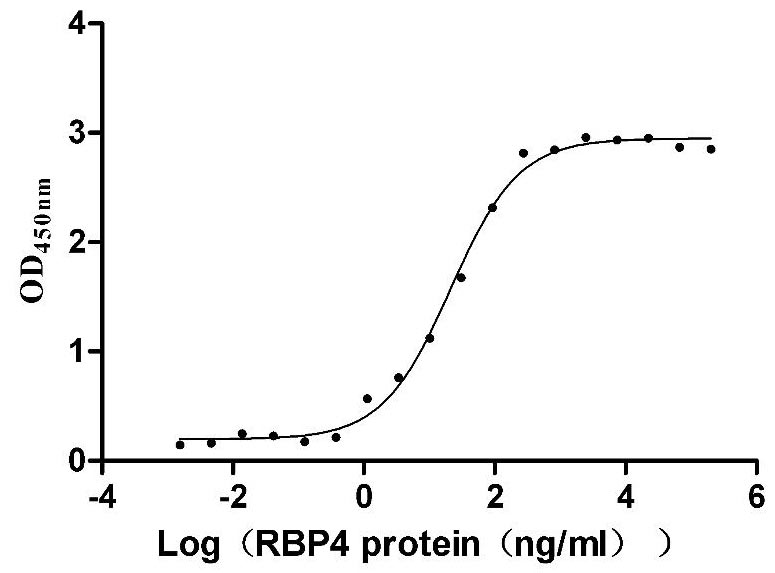Recombinant Mouse Delta-like protein 3 (Dll3), partial
-
货号:CSB-YP006948MO1
-
规格:
-
来源:Yeast
-
其他:
-
货号:CSB-EP006948MO1
-
规格:
-
来源:E.coli
-
其他:
-
货号:CSB-EP006948MO1-B
-
规格:
-
来源:E.coli
-
共轭:Avi-tag Biotinylated
E. coli biotin ligase (BirA) is highly specific in covalently attaching biotin to the 15 amino acid AviTag peptide. This recombinant protein was biotinylated in vivo by AviTag-BirA technology, which method is BriA catalyzes amide linkage between the biotin and the specific lysine of the AviTag.
-
其他:
-
货号:CSB-BP006948MO1
-
规格:
-
来源:Baculovirus
-
其他:
-
货号:CSB-MP006948MO1
-
规格:
-
来源:Mammalian cell
-
其他:
产品详情
-
纯度:>85% (SDS-PAGE)
-
基因名:
-
Uniprot No.:
-
别名:Dll3; Delta-like protein 3; Drosophila Delta homolog 3; Delta3; M-Delta-3
-
种属:Mus musculus (Mouse)
-
蛋白长度:Partial
-
蛋白标签:Tag type will be determined during the manufacturing process.
The tag type will be determined during production process. If you have specified tag type, please tell us and we will develop the specified tag preferentially. -
产品提供形式:Lyophilized powder
Note: We will preferentially ship the format that we have in stock, however, if you have any special requirement for the format, please remark your requirement when placing the order, we will prepare according to your demand. -
复溶:We recommend that this vial be briefly centrifuged prior to opening to bring the contents to the bottom. Please reconstitute protein in deionized sterile water to a concentration of 0.1-1.0 mg/mL.We recommend to add 5-50% of glycerol (final concentration) and aliquot for long-term storage at -20℃/-80℃. Our default final concentration of glycerol is 50%. Customers could use it as reference.
-
储存条件:Store at -20°C/-80°C upon receipt, aliquoting is necessary for mutiple use. Avoid repeated freeze-thaw cycles.
-
保质期:The shelf life is related to many factors, storage state, buffer ingredients, storage temperature and the stability of the protein itself.
Generally, the shelf life of liquid form is 6 months at -20°C/-80°C. The shelf life of lyophilized form is 12 months at -20°C/-80°C. -
货期:Delivery time may differ from different purchasing way or location, please kindly consult your local distributors for specific delivery time.Note: All of our proteins are default shipped with normal blue ice packs, if you request to ship with dry ice, please communicate with us in advance and extra fees will be charged.
-
注意事项:Repeated freezing and thawing is not recommended. Store working aliquots at 4°C for up to one week.
-
Datasheet :Please contact us to get it.
相关产品
靶点详情
-
功能:Inhibits primary neurogenesis. May be required to divert neurons along a specific differentiation pathway. Plays a role in the formation of somite boundaries during segmentation of the paraxial mesoderm.
-
基因功能参考文献:
- Structural deformities of the vertebral column and adjacent ribs in the pudgy mouse are caused by mutations in Dll3. Review. PMID: 27655002
- Dll3 overexpression promoted PI3K/Akt signaling through inhibiting Notch signaling in lung cancer. PMID: 28007595
- O-fucosylation of DLL3 is required for its function during somitogenesis. PMID: 25856312
- Intriguing changes are observed in the cranio-caudal borders of multifidus muscle in mutant Dll3 and Lfng models of idiopathic scoliosis. PMID: 22095884
- Dll3 has a unique function during T-cell development that is distinct from the role played by the other DSL ligands of Notch. PMID: 21151194
- Dll3 targets Notch1 for lysosomal degradation preventing Notch1 from undergoing post-translational processing. PMID: 21147753
- Axial skeletal defects caused by mutation in the spondylocostal dysplasia/pudgy gene Dll3 are associated with disruption of the segmentation clock within the presomitic mesoderm. PMID: 11923214
- DLL3 knockout mice have segmentation and neural defects PMID: 12141422
- spondylocostal dysostosis (SCD) is caused by mutation in Delta-like 3 (DLL3), Mesoderm posterior 2 (MESP2), and Lunatic fringe (LFNG); three genes that are components of the Notch signaling pathway. PMID: 17600782
- study reports that another Notch ligand, Dll3, is expressed in developing hair cells, in a pattern that overlaps that of Dll1 and Jag2; Dll3 may play a role in lateral inhibition similar to that of Dll1 and Jag2 PMID: 17823936
- study shows that genetic interactions between Notch1 and Dll3 result in vertebral segmental defects similar to those seen in congenital scoliosis; craniofacial anomalies not previously observed in Dll3 homozygous animals were identified PMID: 17849441
- Dll3 are expressed in the developing mouse eye and in retinal progenitor cell. PMID: 19191219
- a complex interplay of E-box binding proteins spatially and temporally regulate Dll3 levels during neural tube development. PMID: 19389376
- Data show that the ubiquitin ligase Huwe1 operates upstream of the N-Myc-DLL3-Notch pathway to control neural stem cell activity and promote neurogenesis. PMID: 19686682
显示更多
收起更多
-
相关疾病:A truncating mutation in Dll3 is the cause of the pudgy (pu) phenotype. Pudgy mice exhibit patterning defects at the earliest stages of somitogenesis. Adult pudgy mice present severe vertebral and rib deformities.
-
亚细胞定位:Membrane; Single-pass type I membrane protein.
-
组织特异性:Predominantly expressed in the neuroectoderm and paraxial mesoderm during embryogenesis.
-
数据库链接:
KEGG: mmu:13389
STRING: 10090.ENSMUSP00000103951
UniGene: Mm.12896
Most popular with customers
-
Recombinant Human Semaphorin-4D (SEMA4D), partial (Active)
Express system: Mammalian cell
Species: Homo sapiens (Human)
-
Recombinant Human R-spondin-1 (RSPO1), partial (Active)
Express system: Mammalian cell
Species: Homo sapiens (Human)
-
Recombinant Human Tissue factor pathway inhibitor (TFPI), partial (Active)
Express system: Mammalian cell
Species: Homo sapiens (Human)
-
Recombinant Mouse Transthyretin (Ttr) (Active)
Express system: Mammalian cell
Species: Mus musculus (Mouse)
-
Recombinant Dog Angiopoietin-2 (ANGPT2) (Active)
Express system: Mammalian cell
Species: Canis lupus familiaris (Dog) (Canis familiaris)
-
Recombinant Macaca fascicularis CD44 antigen (CD44), partial (Active)
Express system: Mammalian cell
Species: Macaca fascicularis (Crab-eating macaque) (Cynomolgus monkey)
-
Recombinant Macaca fascicularis Trophoblast glycoprotein (TPBG), partial (Active)
Express system: Mammalian cell
Species: Macaca fascicularis (Crab-eating macaque) (Cynomolgus monkey)
-
Recombinant Human Serine/threonine-protein kinase receptor R3 (ACVRL1), partial (Active)
Express system: Baculovirus
Species: Homo sapiens (Human)




















